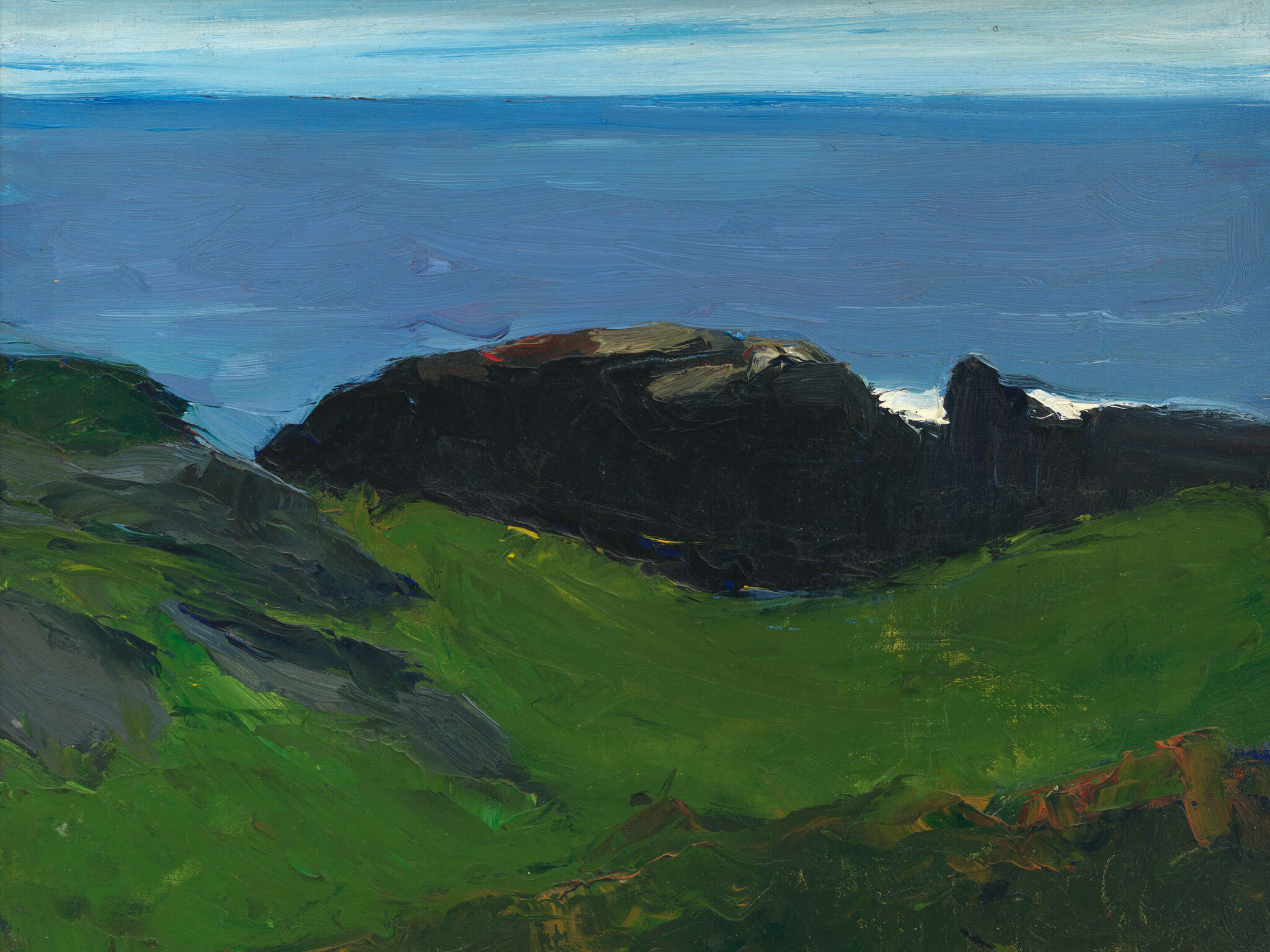The world of the German author Esther Kinsky is the world after Babel. The Biblical story goes like this: once, the people of the world had a single language. They found an empty plain and, having worked out how to bake clay into bricks, decided to build a tower in order to reach the heavens – ‘otherwise’, they feared, ‘we will be scattered over the face of the whole earth’. When God comes to punish them, this is exactly what happens. The tower goes unbuilt, the universal language vanishes. Kinsky, who began her literary career as a translator of Polish, English and Russian, invokes Babel in her book-length essay Fremdsprechen (2013), a manifesto of sorts that sets out her conception of what it means to exist between languages. It begins with an extended riff on the thwarting of the tower of Babel as humanity’s third collective punishment (after the expulsion from Eden and the Flood), one that condemned it to ‘difficulties of comprehension’, to language as a site of otherness.
Yet for Kinksy, the chasm between languages is not a bleak place, but rather a field of resonances, a ‘transit space’, a creative sound-zone. Everyone must face the complex reality of life after Babel; everyone, too, is capable of excavating their personal relationship to language, formed through the accumulation of layers of association and memory, which can be unearthed and probed as Kinsky herself does in a series of autobiographical fragments that conclude the book. Kinsky employs such geological terminology throughout Fremdsprechen: language is likened to clay, loam, bricks.
Language and discontinuity, geological excavation and reconstruction: these are themes that run through the triptych of novels that has made Kinksy’s name in the anglosphere. River (2017), Grove (2018) and now Rombo (2022) – the first translated by Iain Galbraith, the latter two by Caroline Schmidt – have tended to be received as nature writing. Yet Kinsky has rejected this rubric, and for good reason. Not only is her vision of the natural world far less pristine than that found in many of that genre’s naiver examples, but nature in her work is ultimately more of a charged setting than Kinsky’s main subject – a device, or metaphorical resource. Her interest is not in geology itself, but in the geological workings of memory, while her central preoccupation is language – the ‘shapeable material’ of post-Babel Earth.
Kinsksy’s three Geländeromane (‘terrain-novels’) are formally experimental meditations on disturbance – at once geological, personal and linguistic. All are set in the aftermath of loss, and show their narrators trying to come to terms with change. In River, an unnamed narrator – about to leave town for good – wanders the ‘partly mutilated’ mudscapes of east London’s lower Lea Valley, recording what she sees with both photographs and words, journeying into the ‘lower reaches’ of memory:
Hidden in the middle of the large Hackney Marshes Playing Fields, as in the depths of the instant pictures I had taken with my bulky camera, were memories I was only gradually learning to read: the steady drone of an invisible plane above the white cloud cover, chirring pylons lisping messages from the air, the wispy rustling of pale winter grass in the wind, and between it all a stillness that masked the proximity of the city.
Grove, written in the wake of the death of Kinsky’s husband, the translator Martin Chalmers, sees a recently widowed woman move to a small Italian town southeast of Rome; her fragmented, memory-suffused relections on the land and her place in it produce a teetering superimposition of images. Kinsky’s investigation into what she calls ‘disturbed terrain’ finds perhaps its most literal expression in Rombo, about the series of earthquakes that rocked Friuli in northern Italy in 1976, killing around a thousand people, with countless more displaced.
The cataclysm is reconstructed through the fragmentary accounts of several fictional eyewitnesses; this collective narrative is interspersed with a narrator’s intricate descriptions of Friuli’s ecology and landscape, its local flora and fauna:
Up the Rio Nero, the terrain is always wild. The path is forever being shifted by fresh rock falls and descending scree – a terrain of interference in the tenor of events. The scent of resin sits above the sunny barren land, where dwarf pines brace themselves between chunks of rock – the trees so small one might be quicker to attribute to the stones their scent. Beside the pine saplings junipers take root, small bell flowers, heather on blown-in soil.
There are also detailed accounts of Friulian culture and folk customs, including a traditional song dedicated to the mermaid Riba Faronika – sung while undulating one’s hands in front of one’s chest – and the bile maškire performance, which takes pride of place in the region’s carnivals:
The men and women who masquerade in white all wear the same costume: a long white skirt adorned with colourful cording, a white shirt and a colourful belt. On their heads, a prodigious bonnet, bedecked with colourful paper flowers. Some bonnets dangle colourful ribbons that hide one’s face; all roaming strangers by no account recognizable, white as the limestone mountains and not-white as the flowers from the interglacial period that managed to salvage themselves, whiling in the cracks of the limestone peak that towered over the glacier.
As in the story of Babel, the disorienting fallout from the earthquake is social, cultural, linguistic. ‘An earthquake rattles everything and turns it upside down, even the thoughts in your head’, one local observes. ‘My life is this place’, says another. ‘Here I know everything. Every stick and every stone. The animals and the people.’ But then suddenly she doesn’t. Amid the rubble, it is not only the roads and pathways that are thrown into confusion; folktales and social bonds stop making sense too. ‘Work, the neighbourhood, the animals, music – all that was now divided into the before and after’, one resident says. Many families leave the region, never to return. The village cemetery has fallen into disarray. Displaced former locals who have decamped to nearby coastal towns look out towards the sea – the legendary home of the mermaid Riba Faronika: ‘But they said nothing about it, not even to one another, and they didn’t sing either, not even quietly, because it was too late for that – and even had they hummed, out of homesickness or simply from memory, never would they have moved their hands up and down before their breast, imitating a wave or a snake: not here, beneath this endless sky and in the presence of the horizon.’
While River had a looping, forking structure and Grove imitated its photographic leitmotif by layering – or superimposing – different exposures of its subject matter, Rombo’s snatches of memory and information overlap, diverge and rub against each other like tectonic plates. River and Grove were each narrated by a single coherent persona, whereas Rombo’s fractured chorus of voices dramatizes the ruptures created by the trauma of the earthquake. Together, the eyewitness accounts produce a kind of shifting mosaic – one might call it ‘rubble narration’ – which tries to convey the catastrophe, and the community it destroyed, while stranded irredeemably in the aftermath.
As an act of critical reconstruction, one might compare Kinksy’s approach to kitsugi pottery, or to the chunks of ruin and graffiti preserved in Berlin’s rebuilt Reichstag. The cracks are the highlight; the conspicuousness of the commemorative effort is the point. Kinsky’s descriptive exertion – although occasionally wearing in its attention to esoteric detail – is similarly paramount. It is a method for refusing oblivion. In each novel, dislocations of self and setting initiate a process of reorientation. ‘Memory’, one Friulian local says, ‘is something that is being forever woven.’ After the first earthquake, the residents find themselves arguing about what happened:
One argued over the form of the cliffs, the course of the brooks, the trees that avalanches rolled over. About the whereabouts of objects, the order of things in the house, the fate of animals. Each of these arguments was an attempt at orientation, at carving a path through the rubble of masonry, mortar, split beams and shattered dishes, to understand the world anew. To begin living in a place anew. With one’s memories.
In the New Testament, Jesus says that if people keep silent, the stones themselves will speak. Kinsky’s fiction is full of articulate, evocative stones: bits of brickwork in River; the Ravenna mosaics in Grove; Rombo’s twisted geological layers. But can stones be made to speak of absence, of loss? In Rombo, the loss in question is not just that of 1976. The novel, after all, is not titled Sisma – Italian for earthquake; Rombo is rather the local term for the subterranean growling that comes before seismic activity. ‘The earthquake is everywhere’, our narrator observes. ‘In the mountains’, says one local, ‘something is always shifting’. The narrator offers various theories about the kinds of tectonic activity that cause such disasters; they also note that Friuli is home to some of the deepest cavities on Earth:
What constitutes a cavity? Is it the absence of stone, soil, light – or the presence of walls enclosing it? The darkness within or the light without? When does can’t remember become forgotten, after all? In the early days of geology there was a science of abyssology. A theory of shafts, chasms, voids where forgotten things lie trapped, like tonsil stones. Things lost.
For Kinsky, nature ultimately provides no escape from loss, no solace or release from human tragedy (it is sometimes, as with the earthquake, the cause of it). What it may offer, however, is the possibility of coming to terms with this absence-filled world. Kinsky’s nature is never quite cruel, but it is utterly indifferent to humans’ emotional claims. As she once remarked in an interview: a landscape ‘touches our heart, but doesn’t itself have a heart’. Yet her strikingly unsentimental novels seem to suggest that to attend to the natural world, in all its icy, violent otherness, is to begin to find ourselves a place in it.
Read on: Jonathan Rosenbaum, ‘Rural Sensualist’, Sidecar.






